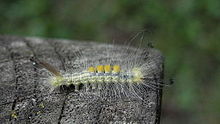tr
kırıntılardaki isimler


Orgyia definita, the definite tussock moth or definite-marked tussock moth, is a moth of the family Erebidae. It was first described by Alpheus Spring Packard in 1865.[1] The species is found in eastern North America from Minnesota to New Brunswick and south to South Carolina, Mississippi, and Louisiana.[2][1]
The wingspan is about 30 mm for males; females are wingless. Adult males are brown with a darker pattern and some white markings.
The larvae feed on Salix, Quercus, Tilia, Ulmus, Betula, Acer rubrum, and Hamamelis virginiana. They have a yellow head, prothoracic plate and dorsal glands. The body is covered in whitish hairs and the verrucae (wart-like structures on the body) are pale yellow.

Orgyia definita, the definite tussock moth or definite-marked tussock moth, is a moth of the family Erebidae. It was first described by Alpheus Spring Packard in 1865. The species is found in eastern North America from Minnesota to New Brunswick and south to South Carolina, Mississippi, and Louisiana.
The wingspan is about 30 mm for males; females are wingless. Adult males are brown with a darker pattern and some white markings.
The larvae feed on Salix, Quercus, Tilia, Ulmus, Betula, Acer rubrum, and Hamamelis virginiana. They have a yellow head, prothoracic plate and dorsal glands. The body is covered in whitish hairs and the verrucae (wart-like structures on the body) are pale yellow.
 Larva in Guelph, Ontario, Canada
Larva in Guelph, Ontario, Canada
Orgyia definita is een donsvlinder uit de familie van de spinneruilen (Erebidae).[1] De wetenschappelijke naam van de soort is voor het eerst geldig gepubliceerd in 1864 door Packard.
Bronnen, noten en/of referenties